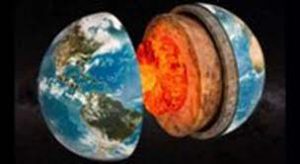E Prime Layer : Outermost Part Of Earth’s Core

A study by an international team of researchers revealed the formation of a new enigmatic layer – E prime layer at the outermost part of Earth’s core.
- E prime layer was believed that a material exchange between the core and mantle is small.
- But the experiments revealed that when water reaches the core-mantle boundary, it reacts with silicon in the core, forming silica.
- This latest research suggests that tectonic plates carrying surface water have transported it deep into the Earth over billions of years.
- Upon reaching the core-mantle boundary about 1,800 miles below the surface, this water initiates significant chemical changes, influencing the core’s structure.
- Scientists have observed that subducted water reacts chemically with core materials under high pressure.
- This reaction leads to the formation of a hydrogen-rich, silicon-depleted layer at the outer core, resembling a film-like structure.
- Silica crystals generated by this process ascend and blend into the mantle, impacting the overall composition.
- These modifications in the liquid metallic layer could potentially result in reduced density and altered seismic characteristics, aligning with anomalies detected by seismologists.
- This discovery enhances researchers’ comprehension of Earth’s internal mechanisms, indicating a broader and more intricate global water cycle than previously acknowledged.




